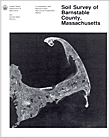The following is a map unit description from the "Soil Survey of Barnstable County, Massachusetts (Fletcher, 1993)"

CdC-Carver coarse sand, 8 to 15 percent slopes. This very deep, strongly sloping, excessively drained soil is on small hills and ridges in areas of ice-contact deposits and on the side slopes of swales on outwash plains. It makes up approximately 8.6 percent (22,004 acres) of the survey area. It is mapped throughout the county. Areas are irregular in shape and range from 5 to 500 acres in size.
Typically, the surface is covered with an organic layer. This layer is about 1 inch of loose, undecomposed pine needles, leaves, and twigs and 2 inches of matted, partly decomposed and well decomposed organic material. The surface layer is brown, loose coarse sand about 7 inches thick. The subsoil is coarse sand about 33 inches thick. The upper 1 0 inches is strong brown and very friable, the next 9 inches is yellowish brown and very friable, and the lower 14 inches is brownish yellow and loose. The substratum to a depth of 65 inches or more is light yellowish brown, loose coarse sand.
Included with this soil in mapping are small areas of Eastchop, Hinckley, Merrimac, and Plymouth soils and areas where slopes are less than 8 percent or more than 15 percent. Included soils make up about 25 percent of this unit.
Permeability is very rapid in the subsoil and substratum of the Carver soil. Available water capacity is very low. Depth to the seasonal high water table is more than 6 feet.
Most areas are used as woodland. Some areas have been developed for homesites, and a few areas are used as pasture or hayland.
This soil is very poorly suited to hay and pasture. The main management objective is the prevention of overgrazing, which reduces the hardiness and density of desirable plants. Proper stocking rates, timely grazing, and restricted use during wet periods help to maintain plant density and minimize surface compaction.
Because of the droughtiness, this soil is poorly suited to woodland. Thinning dense stands to standard stocking levels results in more vigorous tree growth. Diseased, deformed, and otherwise undesirable trees should be removed when the stands are thinned. The most common trees are pitch pine, scrub oak, and white oak. Generally, these trees are of poor quality and seldom attain heights of more than 25 feet.
The slope is a limitation if this soil is used as a site for buildings. Land shaping is generally needed. Buildings and lots should be designed so that they conform to the natural slope of the land. Erosion is a hazard during and after construction. Planting well suited grasses as soon as possible after the surface is disturbed minimizes the erosion hazard.
This soil is limited as a site for septic tank absorption fields because of the slope and the very rapid permeability in the substratum. The soil may not adequately filter the effluent. The poor filtering capacity may result in the pollution of ground water. The hazard of pollution increases with the density of housing. Installing the distribution lines on the contour or in areas that were graded during construction of the dwelling helps to overcome the slope. Precautionary measures may be necessary in some areas.